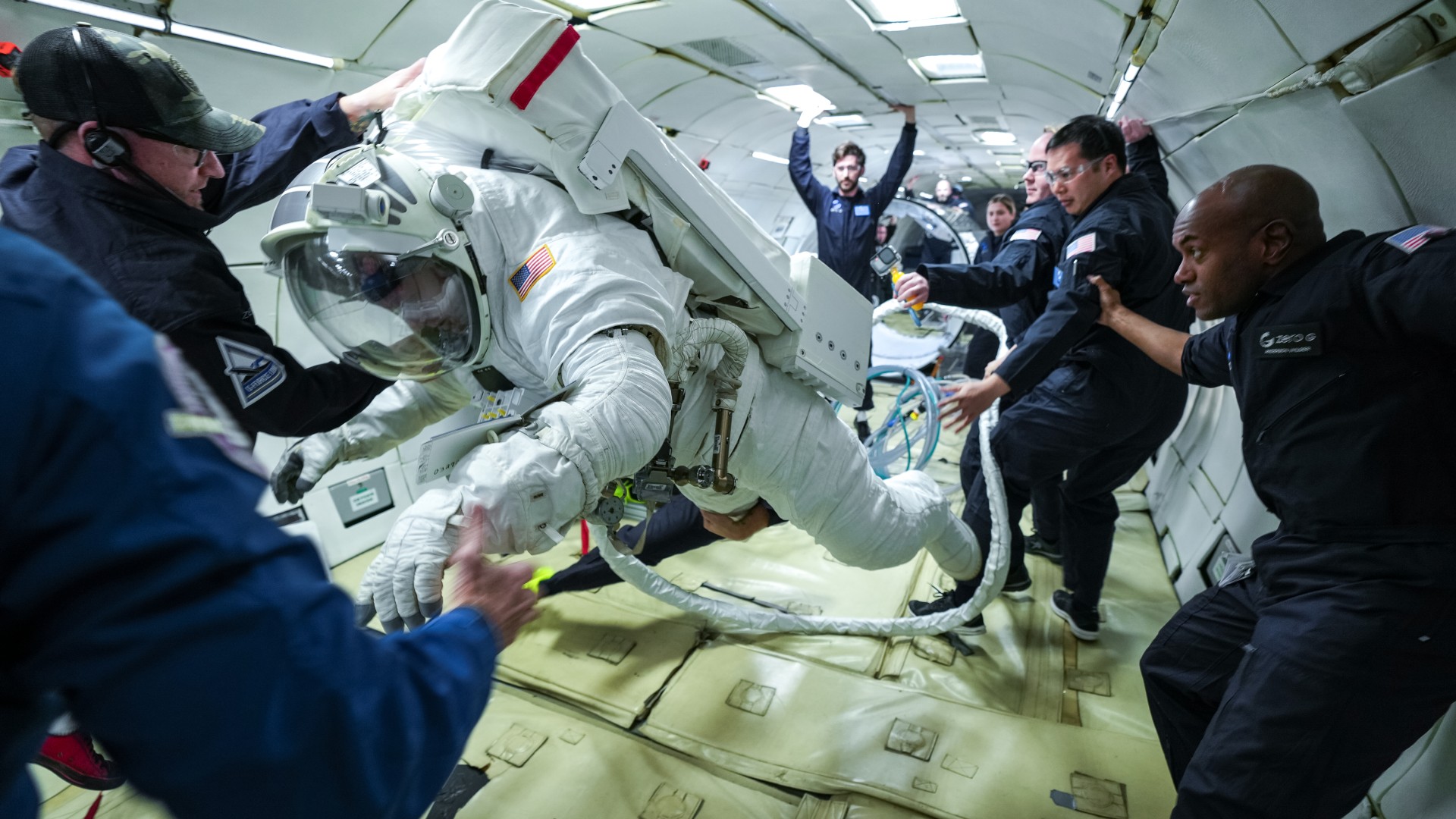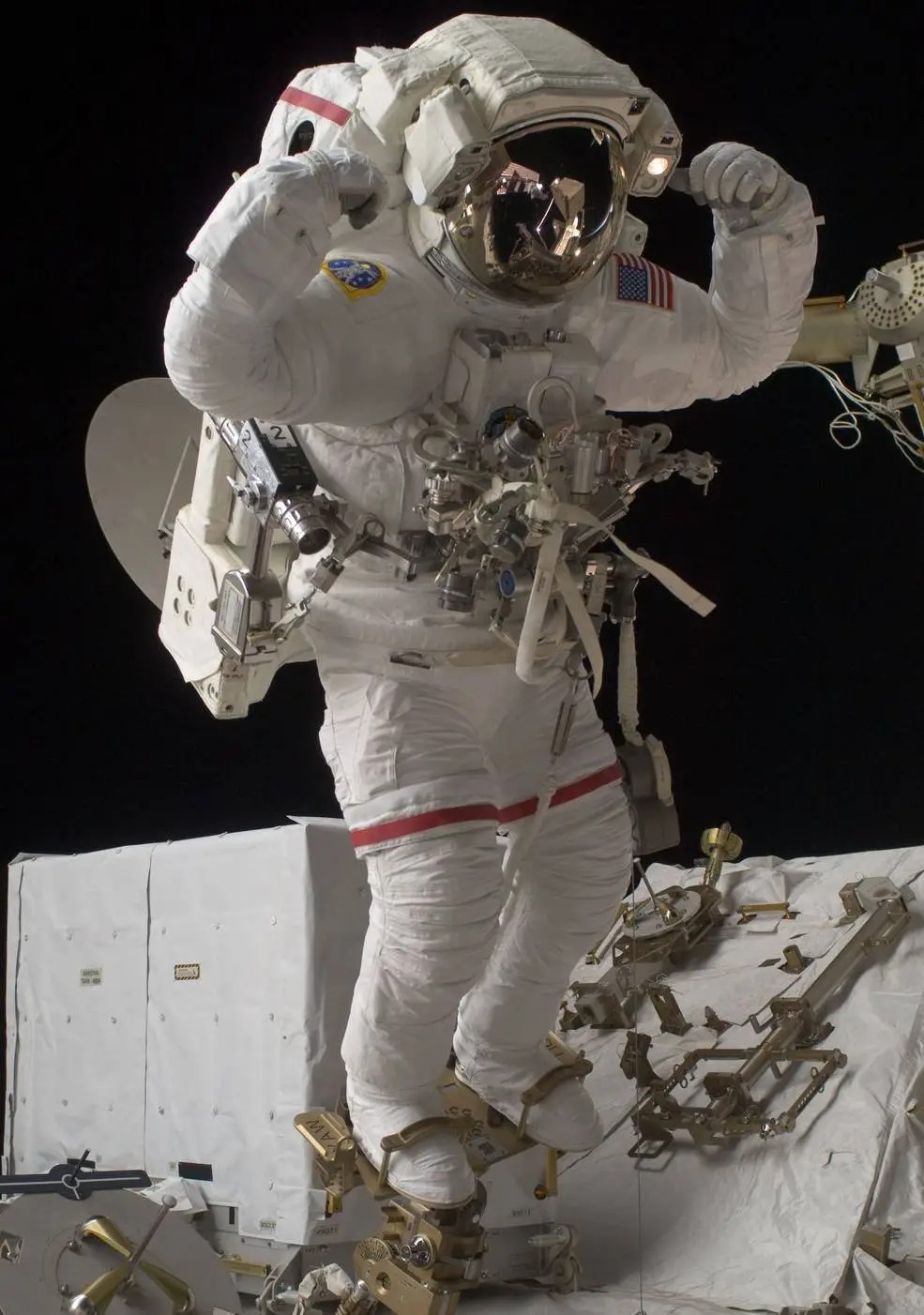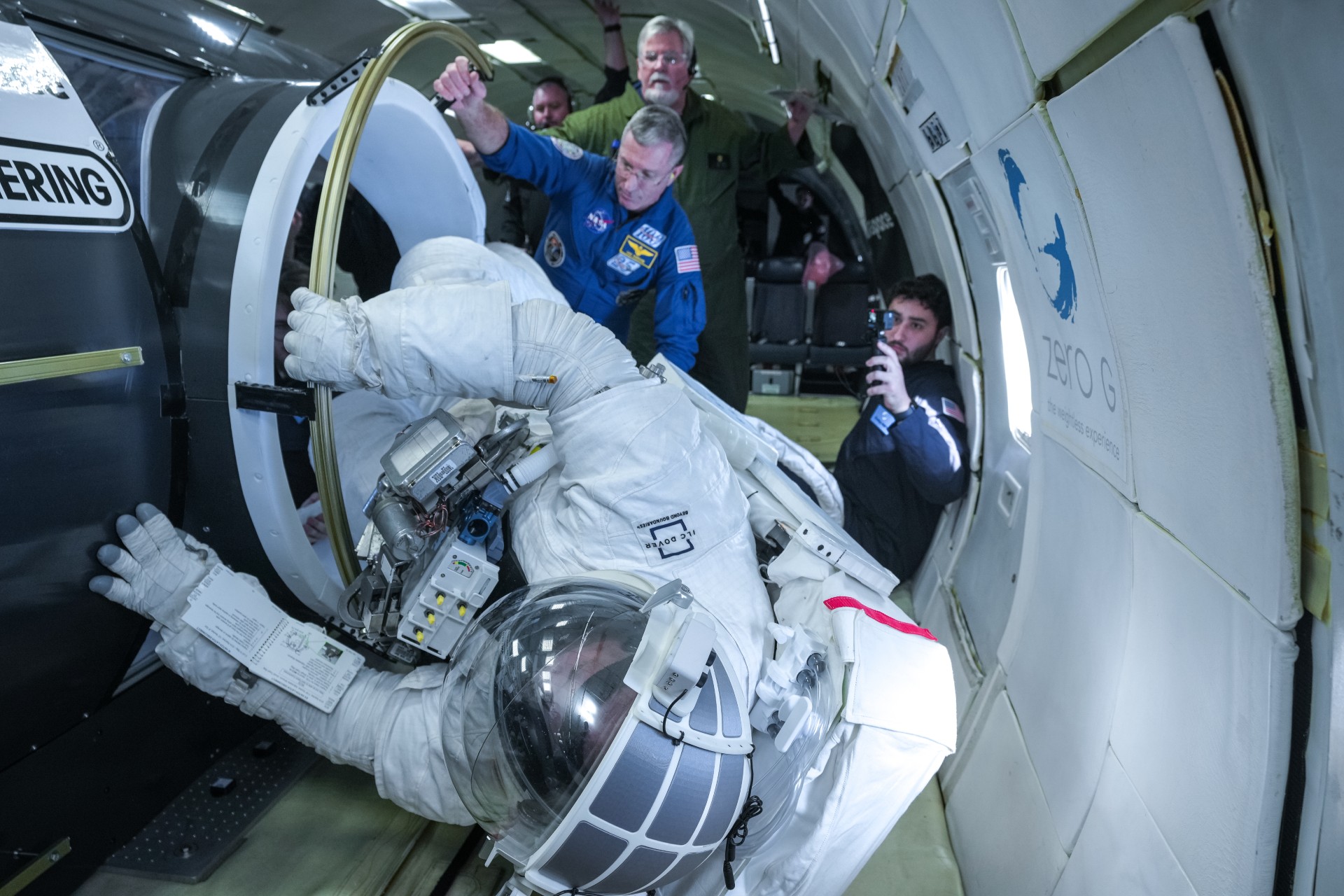This astronaut took 5 spacewalks. Now, he's helping make spacesuits for future ISS crews (exclusive)
"The answer to that is practice, practice, practice, practice, practice, practice."

The next generation of spacesuits for astronauts just went parabolic.
Collins Aerospace tested its new spacesuit design, built for International Space Station spacewalks, on a parabolic flight that simulated microgravity conditions. The goal was to fulfill requirements for a NASA contract aimed at replacing the long-standing extravehicular mobility units (EMUs) now used on the orbiting complex.
Following the news release on Feb. 1, Collins chief test astronaut John "Danny" Olivas — a retired NASA astronaut — spoke with Space.com about the company's plans for the floating suit. He also discussed exciting possibilities for moon exploration. Read on to learn more about how Olivas is using his past spacewalking experience to pave the way for future spacewalkers.
Collins received a 2022 task order from NASA to develop a next-generation EMU to be lighter and more flexible than current spacesuits. These suits are also under consideration to become moonwalking outfits for the agency's Artemis program; the design team received a separate task order in July 2023 to modify the floating-style spacesuits for surface excursions.
Related: Watch next-generation lightweight spacesuit tested on Zero-G flight (photos, video)
Space.com: What sorts of experiences were you able to port from your time at NASA to Collins, to help with the development?
Danny Olivas: I've been an engineer for over 35 years. I've always been fascinated about space. It is very much like coming home and being part of an engineering family where we toil away to produce things that are safe, efficient and effective for our clients.
Get the Space.com Newsletter
Breaking space news, the latest updates on rocket launches, skywatching events and more!
The intent is basically, "right design" this suit. It should be a suit that is intuitive to the astronauts. So I feel like what I'm bringing to the table is essentially helping the engineers understand what is important, where do things need to be placed, what are the things that you need to be considering. For example, in December of last year, we completed an exercise called the "concept of operations." That essentially is evaluating the suit in an environment like you're integrated onto a spacewalk and then coming back from doing a spacewalk.
I was able to bring to the table: when we do our prep and post, here's what we do. Here's what we did on orbit. Here's how we work to this particular issue. Through that exercise, it provided feedback directly to the engineers on how to move forward. It's not a one and done thing. It's a collaboration: we've gone, and taken a look at that, and we can do this — or we can't do that.
Related: Shuttle astronaut Danny Olivas talks diversity on Earth (and space) in 'Virtual Astronaut' webcast

I feel like I'm bringing everything I can to this. This likely going to be my last job, and I'm going to be on the field. I care about the astronauts: that we're building the spacesuits for the people who got me five spacewalks, and did so in a safe manner. I owe it to them, to give back to the engineering community: everything I can to help our team be successful and provide the safest and most efficient, most effective spacesuit for the next generation of explorers. That's the very least I owe for being given the opportunity.
Space.com: Can you step us through the development?
Olivas: Collins, with our partners ILC Dover Astrospace and Oceaneering, use heritage or legacy from the original Hamilton Standard suit technology, which is something that's been ingrained in the company DNA from the Apollo missions. The A7L spacesuit was the first one that was formed, all the way through the current EMU. It makes perfect sense that we are looking at extending to the next generation spacesuit for the International Space Station.
The intent is for NASA delivery and, at that point, we'll have a new suit on the space station that will not only be for the space station, but also will be applicable for other commercial destinations after ISS. That includes lunar landings as well; as you're familiar with, Axiom Space won the contract for the lunar suit and they're destined for their launch on (first moon landing) Artemis 3. We wish them the very best of luck. But we're also making a suit that's compatible with lunar applications. We look to be a continued competitor in the lunar space as well, because that is the future of exploration.

Space.com: What happened during the parabolic campaign?
Olivas: This campaign actually began over a year ago, when it was first decided that we would conduct a portion of the crew capability assessment in a microgravity environment. There's no 1 G equivalent that would give you confidence that the things that you would be doing could be applicable in microgravity. We looked at some of the more challenging things, such as airlock egress and ingress. Collins has built a mockup that was to scale.
Getting this this new suit across the hatch was vital to demonstrate that you have the ability to be able to do so, and the geometry of the suit would in fact actually go through there. So that was a big risk, especially if you consider that you only have a parabola to be able to demonstrate that. Sometimes getting in and out of the airlock can take upwards of a couple of minutes, but you don't get that liberty if you're doing a zero-G flight.
Related: I flew weightlessly on a parabolic flight to see incredible student science soar

The answer to that is practice, practice, practice, practice, practice, practice. We were literally, on a weekly basis, writing the choreography of what we would do on each and every parabola. Every team member was there. We knew where we were going to be positioned. The whole idea was that you want to be out of the way when it's time to go to the task, when there's limited time to be able to do that. And it worked flawlessly.
I learned some things. Trying to stand on your feet on a footplate makes it a bit challenging, so for me, it was trying to learn how to operate in this – I would call it a bronco, if you will. Certainly there were oscillations. But we were still able to demonstrate that you could get inside a portable foot restraint within 20 seconds.

Space.com: Can you give a comparison about what it's like to be working in the current EMU compared with what Collins is going to be able to offer?
Olivas: From the outside, probably not a lot. You're going to see two arms, two legs, a helmet and a layer of white. The secret sauce is below that layer of white. There's no technology that's carried over from the EMU, but what has been carried over is all the lessons learned against this concept in doing this from day one. We bring all that experience and heritage with the suit into the development designers.
Now let's talk about the difference between the EMU and the next generation suit. It is like night and day. I'm talking strictly right now from the PGS – the pressure garment system, the mobility aspect of it. Things that would lock you up in the suit on orbit. By the way, lockup issues — especially with shoulder joints — are part of the reason why we had an injury rate.
As we think of accessibility to the lunar application, we have intentionally gotten rid of a component called the waist bearing assembly, the ability to essentially pivot around the waist. In exchange we have introduced hip joints, joints which work in unison to allow for walking. This gives us a lot more flexibility in the lower extremities. I think the increasing range of motion, increased maneuverability are probably the biggest attributes that I've seen.
Space.com: Anything else would you like to add?
Olivas: I would say, help me carry forward the message about what the suit is. As much as this machine is to keep the human being alive in the space — like solo spacecraft — it's the contributions that make it right. It's all those engineers who go through kind of an anonymous perspective in their entire career, and you're never really knowing what they do. But it just happens because of a human being behind it. That team, I'm part of today, and I want to make sure that that becomes clear.
This interview was edited and condensed. This article was amended at 2:15 p.m. EST Feb. 14 to add information about other companies involved with the Collins spacesuit and to address a typo.
Join our Space Forums to keep talking space on the latest missions, night sky and more! And if you have a news tip, correction or comment, let us know at: community@space.com.

Elizabeth Howell (she/her), Ph.D., was a staff writer in the spaceflight channel between 2022 and 2024 specializing in Canadian space news. She was contributing writer for Space.com for 10 years from 2012 to 2024. Elizabeth's reporting includes multiple exclusives with the White House, leading world coverage about a lost-and-found space tomato on the International Space Station, witnessing five human spaceflight launches on two continents, flying parabolic, working inside a spacesuit, and participating in a simulated Mars mission. Her latest book, "Why Am I Taller?" (ECW Press, 2022) is co-written with astronaut Dave Williams.









